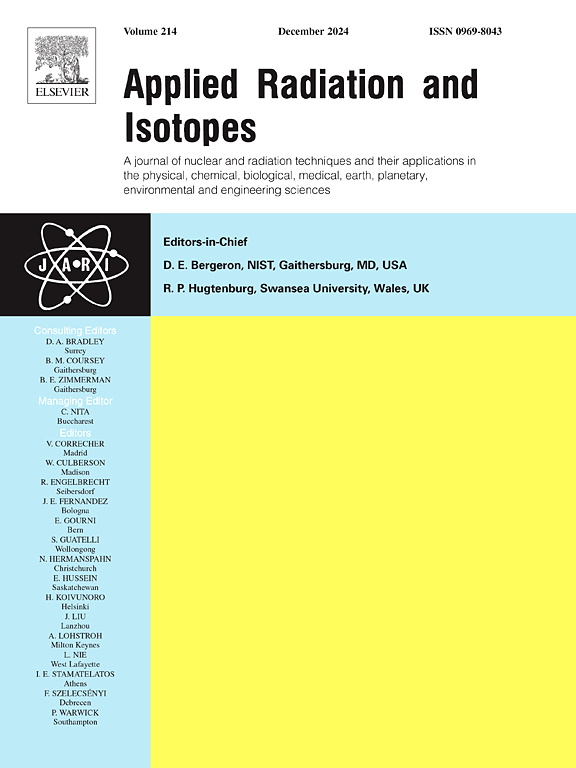用克里格模型构建响应面,快速估计乏核燃料中放射性核素的活度
IF 1.6
3区 工程技术
Q3 CHEMISTRY, INORGANIC & NUCLEAR
引用次数: 0
摘要
在每个运行周期结束时,从核电站反应堆堆芯排出的乏燃料通常被暂时储存在冷却池中,最终将被放入埋在地表以下500米的废料罐中。随着时间的推移,这些燃料组件内的放射性同位素继续衰变并释放辐射,可能对生物圈构成威胁。为了解决这一问题,监测放射性同位素活动随冷却时间的变化是至关重要的。本研究探索了一种间接方法,利用克里格模型构建响应面,对不同冷却时间的乏核燃料中关键放射性核素的活性进行快速评估。以台湾金山核电站1号机组的数据为例,根据初始铀-235浓度、总燃耗和比功率等参数,从存储有3390个燃料组件的池中选择了1855个乏燃料组件。然后使用SCALE 6.2对选定的组件进行分析,以计算对安全至关重要的放射性同位素的活度,形成一个综合数据库。选取合适的参数可以建立合适的克里格模型。该过程包括三个主要步骤:初始采样,建立响应面估计的克里格模型,以及基于允许的最大误差的优化。这一迭代过程得到了估计响应面的最优克里格模型。响应面考虑了四个变量:比功率、初始铀235浓缩、总燃耗和冷却时间。利用台湾金山电厂和国胜电厂的乏燃料对克里格模型进行了验证,结果表明,响应面可以很好地预测核素活性随冷却时间的变化,这意味着该方法可以用于安全有效的核废料管理。本文章由计算机程序翻译,如有差异,请以英文原文为准。
Constructing response surfaces with Kriging models for quick estimation of radionuclide activity in spent nuclear fuel
Spent nuclear fuel discharged from the reactor core of a nuclear power plant at end of each operating cycle is usually temporarily stored in cooling pools and eventually will be placed in waste canisters buried 500 m below the surface. Over time, radioactive isotopes within these fuel assemblies continue to decay and release radiation, potentially posing risks to the biosphere. To address this concern, monitoring the variation in radioisotope activity with cooling time is essential.
This study explores an indirect method employing a Kriging model to construct response surfaces to perform a quick assessment of activity of key radioactive nuclides in spent nuclear fuel at various cooling times. Using data from Taiwan's Chinshan Nuclear Power Plant Unit 1 as an example, 1855 spent nuclear fuel assemblies were selected from a pool stored with 3390 fuel assemblies, based on parameters such as initial uranium-235 enrichment, total burnup, and specific power. The selected assemblies were then analyzed using SCALE 6.2 to calculate the activities of radioisotopes critical to safety, forming a comprehensive database.
Properly selected parameters enabled the establishment of an appropriate Kriging model. The process involved three major steps: initial sampling, Kriging model establishment for response surface estimation, and optimization based on maximum errors allowed. This iterative process resulted in the optimal Kriging model for estimating the response surface. The response surface considered four variables: specific power, initial uranium-235 enrichment, total burnup, and cooling time.
Validation of the Kriging models using spent nuclear fuel from Taiwan's Chinshan Power Plant and Kuosheng Power Plant showed that the response surfaces well-predicted the nuclide activity as it varies with cooling time, implying that the method may be used by the utility for safe and efficient management of nuclear waste.
求助全文
通过发布文献求助,成功后即可免费获取论文全文。
去求助
来源期刊

Applied Radiation and Isotopes
工程技术-核科学技术
CiteScore
3.00
自引率
12.50%
发文量
406
审稿时长
13.5 months
期刊介绍:
Applied Radiation and Isotopes provides a high quality medium for the publication of substantial, original and scientific and technological papers on the development and peaceful application of nuclear, radiation and radionuclide techniques in chemistry, physics, biochemistry, biology, medicine, security, engineering and in the earth, planetary and environmental sciences, all including dosimetry. Nuclear techniques are defined in the broadest sense and both experimental and theoretical papers are welcome. They include the development and use of α- and β-particles, X-rays and γ-rays, neutrons and other nuclear particles and radiations from all sources, including radionuclides, synchrotron sources, cyclotrons and reactors and from the natural environment.
The journal aims to publish papers with significance to an international audience, containing substantial novelty and scientific impact. The Editors reserve the rights to reject, with or without external review, papers that do not meet these criteria.
Papers dealing with radiation processing, i.e., where radiation is used to bring about a biological, chemical or physical change in a material, should be directed to our sister journal Radiation Physics and Chemistry.
 求助内容:
求助内容: 应助结果提醒方式:
应助结果提醒方式:


